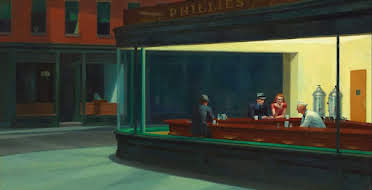The Iconic “Nighthawks” Painting: A Masterpiece of Urban Isolation
Edward Hopper’s “Nighthawks” is a timeless masterpiece that captures the essence of urban loneliness and isolation. Painted in 1942, this iconic piece has become synonymous with American art and culture, evoking a sense of mystery and contemplation in viewers around the world.
The painting features a late-night diner with four individuals seated inside, bathed in the eerie glow of fluorescent lights. The scene is set against a stark, empty street outside, emphasizing the desolate atmosphere of the urban landscape. The figures appear lost in their own thoughts, creating a palpable sense of solitude and disconnection.
Hopper’s meticulous attention to detail is evident in every aspect of the painting – from the stark geometric shapes of the diner’s interior to the subtle play of light and shadow. The composition is carefully crafted to draw the viewer’s eye towards the central figures, inviting speculation about their identities and relationships.
One of the most striking elements of “Nighthawks” is its use of color – or rather, lack thereof. The muted tones and somber palette contribute to the overall sense of melancholy and introspection that pervades the painting. This deliberate choice by Hopper enhances the mood of quiet desperation that permeates the scene.
Despite its seemingly mundane subject matter, “Nighthawks” manages to capture something profound about human experience – our universal longing for connection in a world marked by alienation and anonymity. It serves as a poignant reminder of the fragility of human relationships and the enduring power of art to evoke emotion and provoke thought.
As we gaze upon Hopper’s “Nighthawks,” we are transported into a world suspended in time – a world where solitude reigns supreme, yet where moments of connection are still possible. It is this delicate balance between isolation and intimacy that makes “Nighthawks” not just a painting, but an enduring work of art that continues to resonate with audiences decades after its creation.
Exploring ‘Nighthawks’: 7 Insights into Edward Hopper’s Iconic Painting
- Nighthawks is a famous painting by Edward Hopper.
- The painting depicts people in a diner late at night.
- The use of light and shadow in Nighthawks creates a sense of isolation and loneliness.
- Pay attention to the details in the painting, such as the diner’s interior and the people’s expressions.
- Notice the contrast between the bright interior of the diner and the dark exterior street scene.
- Consider the mood that Nighthawks evokes and how it makes you feel as a viewer.
- Explore the themes of urban alienation and solitude portrayed in Nighthawks.
Nighthawks is a famous painting by Edward Hopper.
“Nighthawks” by Edward Hopper is a renowned painting that has captivated art enthusiasts worldwide. Known for its evocative portrayal of urban isolation and contemplation, this iconic piece showcases Hopper’s mastery in capturing the essence of human emotion within a seemingly mundane scene. The stark imagery and meticulous attention to detail in “Nighthawks” have solidified its status as a timeless work of art that continues to intrigue and resonate with viewers, inviting them to delve deeper into the complexities of the human experience.
The painting depicts people in a diner late at night.
The iconic “Nighthawks” painting by Edward Hopper portrays a scene of individuals gathered in a diner during the late hours of the night. The composition captures the stillness and solitude of the urban setting, with the figures illuminated by the harsh glow of fluorescent lights against the dark exterior. This simple yet evocative depiction of nighttime isolation conveys a sense of quiet contemplation and introspection, inviting viewers to immerse themselves in the mysterious atmosphere of urban life after hours.
The use of light and shadow in Nighthawks creates a sense of isolation and loneliness.
The deliberate use of light and shadow in Edward Hopper’s “Nighthawks” painting plays a crucial role in conveying a profound sense of isolation and loneliness. The stark contrast between the harsh fluorescent light inside the diner and the deep darkness outside intensifies the feeling of solitude experienced by the figures within. The strategic placement of shadows further accentuates the sense of separation and disconnect, emphasizing the emotional distance between the characters and their surroundings. This masterful manipulation of light not only enhances the atmospheric quality of the painting but also serves to underscore the underlying themes of urban alienation and human isolation that resonate throughout Hopper’s iconic work.
Pay attention to the details in the painting, such as the diner’s interior and the people’s expressions.
When exploring Edward Hopper’s “Nighthawks” painting, it is crucial to pay close attention to the intricate details meticulously woven into the artwork. From the subtle nuances of the diner’s interior, with its stark geometric shapes and eerie lighting, to the enigmatic expressions worn by the individuals within, each element contributes to the overall narrative of urban isolation and introspection. By immersing oneself in these details, one can unravel the layers of meaning embedded in the painting, gaining a deeper appreciation for Hopper’s masterful portrayal of human emotion and connection amidst a backdrop of solitude.
Notice the contrast between the bright interior of the diner and the dark exterior street scene.
In the iconic painting “Nighthawks” by Edward Hopper, one striking tip to observe is the stark contrast between the bright, fluorescent-lit interior of the diner and the dark, empty street scene outside. This deliberate use of contrasting light and shadow not only emphasizes the isolation of the individuals inside but also heightens the sense of urban alienation and disconnect. The luminous warmth emanating from the diner stands in stark juxtaposition to the cold, desolate darkness of the exterior, creating a visual tension that underscores the theme of loneliness and longing present in the artwork.
Consider the mood that Nighthawks evokes and how it makes you feel as a viewer.
When contemplating Edward Hopper’s “Nighthawks,” it is essential to consider the profound mood it evokes and the emotional impact it has on viewers. The painting’s somber atmosphere of urban isolation and quiet desperation creates a sense of introspection and melancholy. As a viewer, one cannot help but feel a deep sense of empathy for the individuals depicted in the scene, seemingly lost in their own thoughts amidst the stark, empty cityscape. The evocative use of light, color, and composition in “Nighthawks” elicits a range of emotions, from loneliness to contemplation, ultimately prompting reflection on the complexities of human connection and the fragility of our shared experiences.
Explore the themes of urban alienation and solitude portrayed in Nighthawks.
Explore the themes of urban alienation and solitude portrayed in Edward Hopper’s “Nighthawks” painting, where the stark depiction of individuals isolated within a late-night diner against a desolate urban backdrop captures the essence of modern city life. The somber atmosphere and lack of interaction among the figures emphasize the pervasive sense of loneliness and disconnection that often accompanies urban living, inviting viewers to reflect on the complexities of human relationships and the yearning for connection amidst a bustling yet isolating environment.




